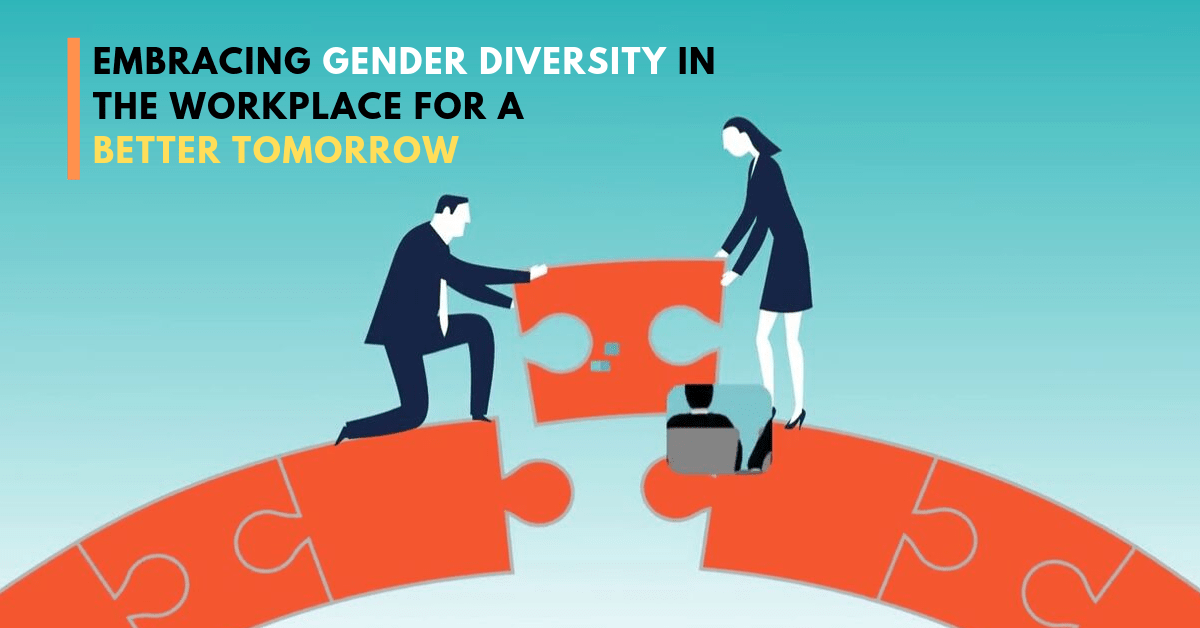
by Raghu Nandhan | Sep 23, 2019 | Blog, Company Insights, Industry Trends
Diversity is imperative to all workplaces. People with completely different backgrounds and experiences, who come close together as a team, will develop innovative ideas that may keep your company alive and thriving. Despite this, companies in many industries and roles are not benefiting from this because they are dominated by a single-sex. For example, tech industry roles are typically filled by men, while nursing roles are typically filled by women. In each case, the customers are more diverse than the people serving them, which don’t bode well for understanding their needs. To better serve your customers, it’s important to cultivate gender diversity within the work.
Gender diversity doesn’t imply that an organization should have a 50/50 mix of males and females for every position in the company. However, it does mean that all the roles should have a fair representation of both sexes at every level in the company.
As leaders, we can employ a range of strategies to improve gender diversity in the workplace.
1. Encourage an inclusive and respectful culture
A survey report points out that though women connected with a lot of everyday slights and disrespectful behavior than men, 58 percent of all employees expertise some kind of micro aggression, suggesting incivility is common at work.
If things need to change, then it can’t just be about driving the culture and values of the company but also highlighting and communicating that there is no room for sexual harassment, disrespect, or bias, and when needed, stringent action will be taken. Communicate, communicate, communicate this a thousand times over, and start at the top.
2. Build a comprehensive workplace
Before making an attempt to hire for gender diversity, look at intervals and appraise your company culture. Is your company a decent place to figure despite gender? Do you treat people across the gender spectrum equally? Consult your employees to learn how you can build a more inclusive workplace, and put in the work to continually improve your company culture. An inclusive culture can facilitate build your employer brand, so you can attract and retain a diverse workforce
3. Restructure your pay and benefits program
To make your company as engaging as potential to a broader range of individual people, you want to erase pay difference between men and women within the same positions.
One way to try and do this is often to prevent asking a few candidate’s previous wage and offer the same pay range to every potential employee, no matter of what they made in an earlier position. Considering that asking candidates regarding their wage history is already prohibited in some states, this is good practice anyway.
When it involves to advantages, studies conjointly show that women in specifically value robust, family-oriented perks once seeking a new job. This means you should be as generous as possible with family leave, health insurance, remote work and flexible hours.
4. Analyze exit interviews
Exit interviews are useful to understand why people are leaving, so you can improve how you hire and retain talent. If you’re working toward gender diversity within the workplace, you‘ll conjointly poke into your differences in why men and women are leaving your organization. This can provide insights that are unique to your company, and allow you to monitor your progress over time. If, for example, you learn that women are less satisfied with compensation than men, you’ll take steps to enhance your compensation strategy and see however perceptions change over a year.
5. Reserve equal seats for women in a boardroom meeting
The higher they’re going; a lot of women realize themselves alone within the room, which typically makes them feel isolated. Companies need to stop having just two women in the boardroom because it checks a box. According to the report, companies need to examine and explore how they can move women through their organization.
The report explains, “One approach is to hire and promote women in cohorts; another is to cluster women on teams. As opposed to staffing one woman on several of teams, companies should consider putting groups of two to three women on teams together.”
And in to move far from reinforcing gender stereotypes, it recommends thinking twice before clustering women in functions traditionally dominated by women, like human resources and communications.
It additionally recommends making opportunities for the “only” women in a room to connect with other alternative women and to foster additional women’s networking teams inside organization.
Above discussed strategies are the few things companies can do for gender diversity and make more money while doing so. Promoting inclusiveness and variety at your workplace is one of the most effective ways that foster an open-minded, global company culture. Not only does this make good business sense serving your company to better understanding colleagues, clients, and customers around the world it additionally makes the workplace a lot interesting and personally enriching environment for everyone.
Connect with us: 




by Raghu Nandhan | Sep 19, 2019 | Blog, Employee Engagement, Industry Trends
Considering millennial’s as the largest generation in the workforce, it’s necessary to find ways to nail the corporate culture since today’s corporate teams are mostly made up of millennial’s.
The millenary wants a strong culture where a company’s values and visions are clearly demonstrated and the work environment is fun.
But to keep these youngest workers from moving on before they fulfil their professional potential, here are following ways to entice the newest, biggest generation of workers to stick with your organization for the rewarding challenges it offers.
Make them engage in purposeful work that hit a larger goal:
Engaging in meaningful work is the foremost priority of millennials. JD is what entices the workforce so it’s important to take a hard look at the job description; process-oriented work is most likely to gain attention for a long time. Money isn’t the only thing driving force rather the work has to be meaningful. It is imperative for organizations to make sure to tie their job into the big picture and help the company fulfill its goals.
Offer transparent & performance-based pay:
These Millennial’s, like other generations are money-motivated, They expect to be fairly compensated, and they grew up with much more access to salary information – on the Internet and through their peers — than earlier generations had.
To retain these Millennial’s, companies need to move away from seniority-based, work-with-the-middle-of-pack approach, and individualize compensation,
and if you want Millennials to stay with your company, never stop offering them, performance based pay and opportunities to add more value and receive greater compensation in return.
Set a pace for rewards.
Millennia’s need to feel that they’re progressing in their field of work; they expect re-enforcement and spot bonuses. They expect to progress through titles and quickly to begin accommodating these preferences with blowing payroll.
Considering bonus strategy — Instead of giving a 3 percent annual raise — Provide a 1 percent increase every four months.
Proving the right Benefits and flexibility in job:
Office culture that promotes work-life balance (the norm these days) as the young generation respond positively to work flexibility. Due to the gig economy, the conventional 9-5 work is no longer the norm. It also encourages creativity and innovation.
To sum up, have an open door policy (sounds cliché but hardly practiced) which gives employees a sense of inclusiveness. Also, companies need to look beyond the ‘millennial’ reputation as job hoppers and focus more on their potential.
Providing guidance and creating opportunities for career development:
Millennial’s prefer bosses or managers who can coach them, guide them and at the same time give them trust and freedom to work on their own manner. And this requires clear disciplined communication, a mix of educational and motivational steps and apt mentor ship. Their skills set system allowing employees to get certified and attain a pay hike accordingly.
Connect with us: 




by Raghu Nandhan | Sep 11, 2019 | Blog, Employee Engagement, Talent Acquisition
There are always certain vacancies in every organization for which employers are not sure whether to hire a permanent employee or not. This dilemma can be resolved by Temp-to-hire services.
The growing trend for employers in recent years has been to use staffing services to fill their open position through a temp-to-permanent or temp-to-hire strategy. The benefit to the employer is the opportunity to test-drive the relationship between the candidate and his job role before making the full-time commitment to him.
Temp-to-hire position is something where the job candidate is typically paid on an hourly rate for specified contract duration. Following that contract duration, the employer of the company or the end client that has hired the candidate has the option to convert him/her as a permanent employee.
In most of the cases, there are 3, 6, 9 or maybe 12 months temp-to-hires, 3-6 months being the most common contract duration.
With the help of Temp to hire services, it’s easier for the clients to test and judge the capability of the candidate. By doing this, the clients can get the right match to the position, by observing and testing the needful skills and qualities of the candidate.
Here are few advantages of temp-to-hire services in the perception of the job-seeker:
Generate Income
Whether you are between successes or embarking on different ventures such as looking at starting a Business, having a contract can sometimes generate immediate income for you in a short term.
Try Before Buy
Buy taking on temp to hire opportunity, you can work for an organization and see if you enjoy the work culture, the team, the work before you actually look at potentially working for this employer on a full-time basis.
Foot in the Door
This role may end up going permanent. So it’s a great way to get your foot in the door with an organization.
Keep Experience
You keep your experience relevant and current by taking on a contract opportunity.
Add experience
You can increase your experience and knowledge base in a particular area. This will be especially true to new comers in a country or to people who are looking to make a complete carrier change.
May Pay more
Typically with contracting, the employers pay a bit more. The reason for this is because they are compensating for lack of extra benefits that contract employees are eligible for.
Grow Network
This is the opportunity to network and meet new people. You never know who you might end up meeting who could be the lead to your dream job.
Easier to Find Job
It’s usually easier to find a job when you are already working. For many recruiters, the Holy Grail is the passive job seeker. So if you are working on a contract, most likely you are going to be targeted more by the recruiters.
Less Competition
Because contracting tends to be a less desirable option than working permanent full- time role, there is less competition in the market place for people who are looking for contract opportunities and with less competition, better your odds are for getting the interview and even getting the job.
There is no way that an employer can truly vet a job seeker effectively in any interview scenario, but temp- to-hire strategy gives you days and weeks to watch someone in action and truly see their skills and most importantly their work ethic.
Firms that adopt a temp-to-hire approach benefit from observing job candidates firsthand — and by hiring people who have gained a familiarity with your firm and its corporate culture. This approach to staffing provides a hands-on, realistic way of choosing a new employee with a lower risk of a hiring mistake.
Hence this is an effective way to get back potential candidates to work and save themselves from making expensive mistakes.
Connect with us: 




by Raghu Nandhan | Sep 10, 2019 | Blog, Industry Trends
A harmful work atmosphere is made once an employee feels afraid, threatened and uncomfortable in his or her workplace due to the offensive behavior, intimidation or abuse by a colleague or superior.
The ongoing distress of a work environment where the pervading attitude is overwhelmingly negative, the management is self-interested and incompetent, and bullying and cliques are rife, makes you more likely to experience depression. It can leave you physically and emotionally drained in your work and personal life. And all that stress and depression can take its toll on your body. If you are undergoing something similar then take a deep breath and continue reading.
Be kind to yourself
The impact of a toxic environment is far-reaching. Prolonged stress is unsustainable. It causes us to break down physically, mentally and emotionally; it destroys our self-esteem; our performance suffers, as do our personal and work relationships. One of the best ways to deal with this is to find the fun and happy folks in your workplace and align with them. Make sure you take care of yourself by eating right, getting enough sleep and exercising. Spend time outdoors and in creative endeavors with people who matter to you. Recharge and regroup. And put out feelers for other opportunities.
Address the issue directly with the offender
On your first encounter of offensive behavior from your colleague or supervisor, it’s always better to bring their attention to their behavior. Stop them before it gets worse.
Inform Management and Human Resources (HR)
When you have tried everything and there is no option left, other than approaching HR and Management, then make sure you have all evidence against the offender. Stay calm and address the issue to Management, and let management handle the matter in their manner instead of you asking to fireside the employee or take action against the offender.
Focus on the Facts, Not the Stories
It will get very easy to get wrapped up in all of the stories being told. It may be simple to create these stories. I encourage you to take a step back, breathe for a second, and focus on the facts. What is happening here and what is not happening? Don’t waste your energy making an attempt to theorize why or why not one thing did or did not happen. Focus on the facts, don’t create stories that explain something regarding you, and keep grounded actually.
Document Everything. Seriously, Everything
Even if your work environment is not specifically “toxic,” you must think about documenting everything. Documentation is not foolproof protection from domineering managers or coworkers determined to throw you below the bus for his or her own mistakes, however it offer some defense. It is always useful to keep a work diary for your growth, but it can come in handy in other ways too. This implies saving and organizing each email associated with projects you’re working on. Make sure you take notes in meetings and on phone calls, and never trusting somebody to recall and agree after you inform them of something they said or did.
Don’t forsake your job
Don’t quit the job due to the toxic environment unless you think the situation remains persistent and you are not satisfied by the action of management or if it is affecting the productivity of your work. It sounds easy to quit the job to cope with such a situation but usually, it is not, setting yourself from one company to another will draw ample energy and time.
You’re not obligated to remain in a harmful workplace, particularly if you’re the sole one doing something regarding it. Your dignity may be disgracefully mocked, but no one can ever take it unless you surrender it willingly. It’s all about making right decisions and finding strength to defend your boundaries.
No one should have to deal with working in a toxic office, but thankfully there are ways around it by using a few of these tips.
Connect with us: 




by Raghu Nandhan | Sep 4, 2019 | Blog, Industry Trends
In today’s organization, it has been seen up to five generations working at one place at one time. And this provides a depth of experience, skill sets and energy, it also presents unique challenges. The generations have its own way of thinking, working and processing information. So it’s important to create a culture that meets the varying needs of each age group.
Let understand first, about the different generations, and what motivates each:
Baby Boomers: Born: 1946 – 1964
Baby Boomers are technologically talented, ambitious and more goal- oriented also motivated by promotions, professional development, a desire to be in a position of authority, and having their expertise valued being acknowledged. They prefer recognition from their peers rather than their supervisors, and they do prefer monetary rewards and value non monetary rewards such as flexible retirement planning. They do not require constant feed backs.
Generation X: Born: 1965 – 1980
Generation X is smaller than the previous and succeeding generations, but they’re often credited for bringing work-life balance. This is because they saw firsthand how their hardworking parents became so burnout. Members of this generation are in their 30’s and 40’s had spent a lot of time alone as children. This created an entrepreneurial spirit with them. In fact, Gen X makes up the highest percentage of start-up founders at 55 percent.
They also value opportunities to grow and make choices, as well as having relationships with mentors. They believe that promotions should be based on competence and not by rank, age, or seniority. Gen X can be motivated by flexible schedules, benefits like telecommuting, recognition from the boss, and bonuses, stock, and gift cards as monetary rewards. Even if they’re not starting their own businesses, Gen X prefers to work independently with minimal supervision.
Generation Y (Millennia’s): Born: 1980 – 1995
Millennia’s (Generation Y) are tech-savvy generation and is currently the largest age group in the country. They’re in their 20’s and are beginning to come into their own in the workforce. They’re the fastest growing segment of today’s workforce. This generation content with selling their skills to the highest bidder. That means unlike Boomers, they’re not as loyal. In most cases, they changes one organization to another. That’s doesn’t mean you can’t motivate this generation; you can motivate them by offering skills training, mentoring, feedback. Culture is also extremely important for Millennia’s. They want to work in an environment where they can collaborate with others. Flexible schedules, time off, and embracing the latest technology to communicate are important for Gen Y.
Generation Z: Born: 1996 Onwards
Generation Z who born 1996 onwards are more interested in social rewards—mentor-ship and constant feedback—than money, but this generation also motivated by meaningful work and being given responsibility. They always keen to know how their work impacts the organization and their role in the organization’s big picture, they always seek for exciting projects which passionate them. They challenge businesses to think about their operational model. This also is the most tech-savvy of the generations. If Millennial’s [Generation Y] were multitaskers, then this group is multitaskers on steroids, and members typically are plugged into five devices at once.
In rewards they prefer include recognition from the boss, experiential rewards and badges such as those earned in gaming. This generation expects workplace flexibility and diversity. Preferred recognition style: regular in-person public praise.
We understood about the different generations, there types and what motivates each, now we let’s understand how to motivate each:-
- By eliminating stereotypes
The biggest reason professionals from different generations are, they don’t want to work together effectively because of preconceived notions about how a certain generation behaves. The Millennial feels that baby boomers are technologically impaired, inflexible and closed-minded, while baby boomers think that millennia’s are entitled and lack a strong work ethic. To eliminate the negative consequences of making assumptions about people’s behavior is to avoid doing it yourself. Being a leader, it’s important to eliminate stereotypes in the way you express yourself and in the way you treat your employees. Whereas, it’s important to evaluate each employee based on their own merit and be mindful of doing so. Too often we succumb to stereotypes without realizing it. So pay attention to the assumptions you’re making about each of your employees, and try eliminating these stereotypes.
- Avoid assuming everyone is on the same page.
When assigning team projects, don’t assume or avoid making general statements about the tasks assuming that everyone processes information the same way. Different generations might understand in different ways, leading to unnecessary clashes when they try to work together.
Before assigning tasks, review the instructions for the following:
- Make sure that they are clear and specific.
- Avoid trendy abbreviations or acronyms.
- List a deadline by date and time.
- Make sure everyone’s role is clearly defined and the point person on the project is identified and understands their role.
- It may require some extra time and effort of yours, but when instructions and expectations are clear, your team will be able to work together more effectively regardless of their age.
- Prepare common ground/Make them agree on common goal.
To make your employees work together, make them to agree on common goal. If there is a motivational factor or goal that speaks to all of your employees, they are more likely to come together to achieve it, no matter how different their strengths or personality type is. That’s your job to determine what’s motivating factor could be.
Think about the following:
- Does the project have a positive effect on society in general? For instance, do you want to implement a new process to reduce environmental waste?
- Does this project help your clients of all age groups? Making out the benefits for older clients and new clients will avoid any inner feelings of favoritism.
- Does this project address a common value important to all of your employees, such as family, personal fulfillment or communication?
- Find their strengths.
While eliminating stereotypes, it is true that every generation has its own skill set. And pairing teams or assigning projects make sure everyone is able to do something that they are good at. For example, if you are working on a new social media campaign, it may be helpful to team up a millennial who knows how to hash tag with a baby boomer who has more experience with client relationships. The baby boomer can provide insight on what clients respond while the millennial can help with phrasing for better social media exposure.
Connect with us: 







